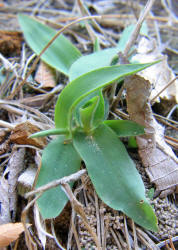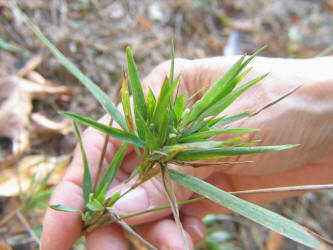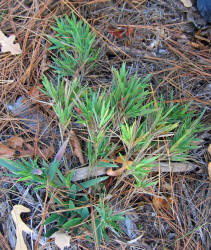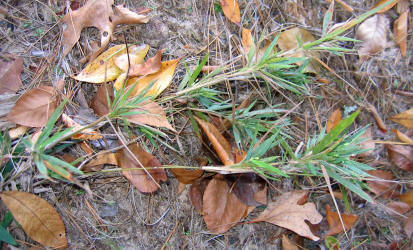Welcome to Catnapin's
Grass Gallery
Poaceae, Panicoideae, Paniceae - Rosettegrass
(Family, Subfamily, Tribe)




tribe Paniceae
Heller's Rosettegrass Dichanthelium oligosanthes
(this may actually be Scribner's Rosettegrass)
This grass changes it's appearance during the year. First growth is wide leaves that twist out. Out of that grow the reclined culms with narrow leaves in rosettes and become branched in autumn. The spring inflorescence is showy and grows well above the leaves. The autumn inflorescence rarely escapes the sheath and is self pollinating. Good cow forage.
Photos taken in Van Zandt & Wood Counties, Texas, November 2006
(Native of Texas - Taylor, Callahan, Brown, Van Zandt, Smith)
Similar Subspecies
Heller's Rosettegrass (Few-flowered Panicgrass) Dichanthelium oligosanthes ssp. oligosanthes
Larger spikelets. Leafs are slightly rolled.
(Native of Texas - Taylor, Van Zandt, Smith)
Base: perennial, no rhizomes, no stolons (runner stem)
Spring Blade (leaf): 3-14cm long, 3-12mm wide, bottom of leaf is uniformly woolly
Rosette Blade: 5-8mm wide, slightly rolled
Sheath (leaf part encircling stem): mixture of wart based long hairs and woolly hairs, tiny hairs on margins, Ligule fringe of hairs 1.6-4.2mm long
Culm (main grain stem): reclined to upright, 10-60cm long, glabrous to hairy, branching in autumn, internodes often purple
May-July Inflorescence: open panicle at end of culm, 4-13cm long and half as wide, lowest branch node is woolly
June-September Inflorescence: enclosed in the sheath from a leaf axis, 2-5cm long, 1-9 spikelets, multiple rebranching with a round spikelet on the end
Spikelet: 2.9-4mm long, 1.2-2.2 wide, blunt
Upper Glume: equal to first lemma, strongly veined, orange to purple spot at the base
Scribner's Rosettegrass (Scribner's Panicgrass) Dichanthelium oligosanthes ssp. scribnerianum
Spikelets are smaller and wider spaced. Shorter and wider leaves. Spot is more prominent.
(Native of Texas - but not Taylor, Van Zandt, Smith)
Base: perennial, no rhizomes, no stolons (runner stem)
Spring Blade (leaf): 3-14cm long, 3-12mm wide, bottom of leaf is glabrous to hairy but not woolly
Rosette Blade: shorter wider and flatter than ssp. oligosanthes
Sheath (leaf part encircling stem): glabrous or with wart based long hairs only, tiny hairs on margins, Ligule fringe of hairs less than 1.6mm long
Culm (main grain stem): reclined to upright, 10-60cm long, glabrous to slightly hairy, branching in autumn, internodes often purple
May-July Inflorescence: open panicle at end of culm, 4-13cm long and half as wide, lowest branch node is glabrous or hairy but not woolly
June-September Inflorescence: enclosed in the sheath from a leaf axis, 2-5cm long, 1-9 spikelets, multiple rebranching with a round spikelet on the end
Spikelet: 2.7-3.3mm long, 1.4-1.8 wide, blunt, sometimes hairy
Upper Glume: equal to first lemma, strongly veined, orange to purple spot at the base that is more prominent than ssp. oligosanthes
Other Species In My Area
Tapered Rosettegrass Dichanthelium acuminatum
(Native of most of Texas - Taylor, Van Zandt, Smith)
Ravenel's Rosettegrass Dichanthelium ravenelii
Very similar to D. oligosanthes ssp. oligosanthes except with larger leaves, larger spikelets, more slender and less robust growth. No glume spot.
(Native of Texas - Smith, Van
Zandt)
Roundseed Rosettegrass Dichanthelium sphaerocarpon
Culm 8"-22" tall, appressed hair at nodes. Inflorescence 2"-4" long, round. Wide leaves have long hairs on edge near base, almost no ligule.
(Native of Texas - Taylor, Van Zandt, Smith)
Copyright Notice: All photos are copyrighted and protected by the laws of the United States.
Unauthorized duplication for sale or distribution is prohibited.